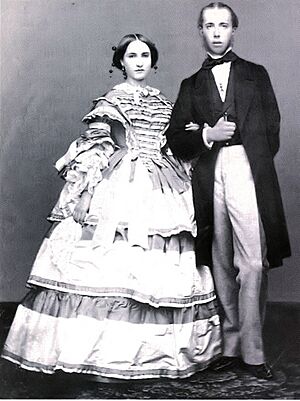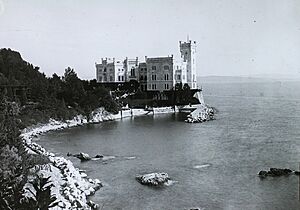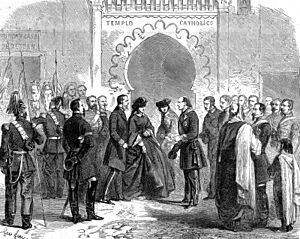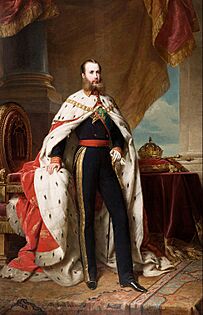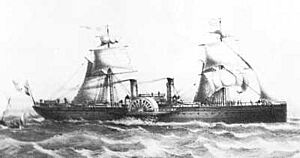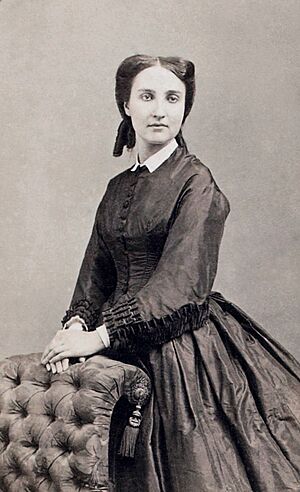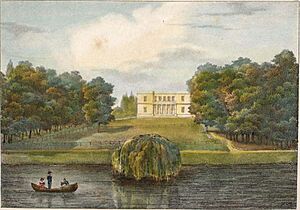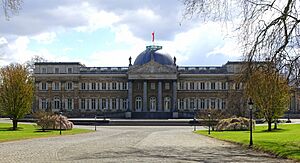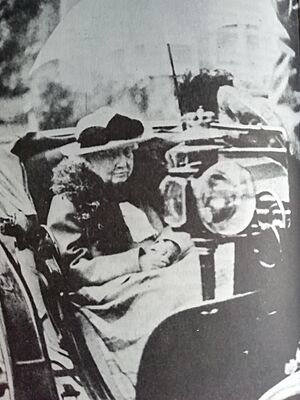Charlotte of Belgium facts for kids
Quick facts for kids Charlotte of Belgium |
|||||
|---|---|---|---|---|---|
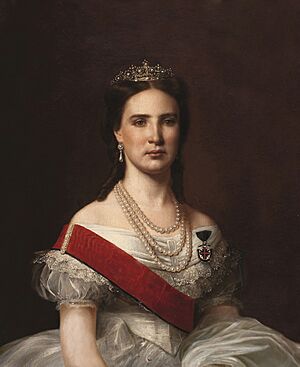
Empress Carlota of Mexico, by Santiago Rebull, 1867. Currently at the Museo Nacional de Arte, Mexico City.
|
|||||
| Empress consort of Mexico | |||||
| Tenure | 10 April 1864 – 15 May 1867 | ||||
| Born | 7 June 1840 Palace of Laeken, Laeken, Brussels, Kingdom of Belgium |
||||
| Died | 19 January 1927 (aged 86) Bouchout Castle, Meise, Kingdom of Belgium |
||||
| Burial | Royal Crypt, Church of Our Lady of Laeken | ||||
| Spouse | |||||
|
|||||
| House |
|
||||
| Father | Leopold I of Belgium | ||||
| Mother | Louise of Orléans | ||||
Charlotte of Belgium (born Marie Charlotte Amélie Augustine Victoire Clémentine Léopoldine; 7 June 1840 – 19 January 1927) was a princess of Belgium. She was also known by the Spanish version of her name, Carlota. She became an Archduchess of Austria in 1857 when she married Archduke Maximilian of Austria. Later, she became the Empress of Mexico in 1864.
Charlotte was the daughter of King Leopold I of Belgium. Her husband, Maximilian, was chosen by Napoleon III of France to rule a new French empire in Mexico. Charlotte helped her husband a lot. She even ruled as a regent when he was away from Mexico City. This makes her one of the first women to rule in the Americas.
Their rule in Mexico lasted only about three years. When Napoleon III stopped supporting them with French soldiers, their situation became very difficult. Charlotte traveled to Europe to ask for help from Napoleon III and the Pope. But her efforts failed. This led to her becoming very unwell.
Maximilian was later captured and executed in Mexico in 1867. Charlotte was brought back to Belgium and lived in Bouchout Castle for many years. She remained unwell until her death in 1927 at the age of 86.
Life Story of Empress Charlotte
Her Birth and Early Years
Charlotte was born on 7 June 1840 at the Palace of Laeken in Belgium. She was the fourth and last child, and the only daughter, of King Leopold I of Belgium and Louise of Orléans. Her first name, Charlotte, honored her father's first wife, Princess Charlotte of Wales.
Her mother, Queen Louise, had a difficult pregnancy with Charlotte. But Charlotte was born healthy. At first, her father was a bit disappointed because he wanted another son. However, he soon grew very fond of Charlotte, and she became his favorite child.
Through her mother, Charlotte was the granddaughter of Louis Philippe I, the King of the French. Through her father, she was a cousin of Queen Victoria of the United Kingdom of Great Britain and Ireland. Because of these family ties, Charlotte often spent holidays with her grandparents in France and with her cousin Queen Victoria at Windsor Castle. She was very close to her grandmother, Queen Maria Amalia. They wrote letters to each other regularly.
When Charlotte was only 10 years old, her mother died on 11 October 1850. This sad event changed Charlotte from a lively child into a more thoughtful and quiet teenager. Her mother had personally guided the children's education. After her mother's death, King Leopold I appointed Countess Denise d'Hulst to be Charlotte's governess.
Charlotte learned to speak and write well in French, English, and German from a young age. Religion was also very important in her life. She was taught by Victor-Auguste-Isidor Deschamps, who later became a Cardinal. Her father believed that royal children needed strong character. He asked them to reflect on their actions often. Charlotte was taught to read and think about The Imitation of Christ every day. By age 13, she enjoyed reading Plutarch. She believed that royalty had a great responsibility to God. At 15, she was seen as a beautiful and dignified young woman. She was very focused on learning and wanted to be morally perfect.
Her Marriage to Maximilian
Charlotte was known for her delicate features and beauty. As the only daughter of the King of the Belgians, she was a desirable match for many princes. In 1856, when she was almost 16, two princes wanted to marry her. One was Prince George of Saxony, who was quickly turned down. The other was King Pedro V of Portugal. Queen Victoria and King Leopold I both favored King Pedro V.
However, Charlotte chose not to marry King Pedro V. She explained that being a queen was a heavy burden. She felt that crowns nowadays brought many challenges.
In May 1856, Charlotte met Archduke Maximilian of Austria in Brussels. He was the younger brother of Emperor Franz Joseph I. Charlotte was immediately charmed by Maximilian, who was eight years older than her. She reportedly said, "it will be him that I will marry." Her father allowed Charlotte to choose her own husband.
Maximilian was less excited about the financial details of the marriage. He described Charlotte as "short" and "brunette," which he thought was good. He also noted she was "very intelligent," which he found "a bit annoying" but thought he would "get over it." The official engagement was announced on 23 December 1856.
The wedding ceremony took place on 27 July 1857 at the Royal Palace of Brussels. This marriage connected the Belgian royal family with the powerful House of Habsburg-Lorraine. This helped make the new Belgian dynasty seem more important and legitimate.
Charlotte's mother-in-law, Archduchess Sophie, welcomed her warmly in Vienna. Sophie saw Charlotte as a perfect wife for an Austrian Archduke. However, this caused tension between Charlotte and Empress Elisabeth of Austria, who was married to Franz Joseph I. Empress Elisabeth was very beautiful and charming, and Charlotte felt that Elisabeth and Maximilian were too close.
Life in Italy and Miramare Castle
In September 1857, Emperor Franz Joseph I of Austria made his brother Maximilian the Viceroy of the Kingdom of Lombardy–Venetia. This region was part of Italy but ruled by Austria. After a brief stop in Vienna, the newly married couple went to Maximilian's Miramare Castle for eight days. They then visited Venice and Verona. On 6 September 1857, Charlotte and Maximilian arrived in Milan, the capital of Lombardy–Venetia. They were welcomed warmly.
In Italy, the Archducal couple lived officially in Milan at the Royal Palace. They also spent time at the Villa of Monza. Maximilian had a large court with many staff. Charlotte also had many ladies-in-waiting and servants. Charlotte seemed to enjoy her time in Venice. She and Maximilian traveled down the Grand Canal in a special gondola. Charlotte also visited schools and charities. They attended many parties and balls.
In 1859, Charlotte bought the island of Lokrum and its old convent. She and Maximilian turned the abbey into a second home. Around this time, Maximilian started spending less time with Charlotte. She felt lonely and bored after a year of marriage.
On 10 April 1859, Maximilian had to resign as Viceroy. His brother, the Emperor, felt that Maximilian was too liberal and spent too much money.
Charlotte and Maximilian then moved to Miramare Castle near Trieste. The castle was still being built in 1860. Maximilian designed it, and Charlotte's dowry helped pay for it. Her brother, the future Leopold II, thought building such a large palace was "limitless madness." Charlotte wrote about their time at Miramare as idyllic. She enjoyed horseback riding, painting, and swimming. She also helped design the castle's beautiful gardens.
In December 1859, Charlotte and Maximilian went on a trip aboard their yacht, the Fantasia. They visited Madeira, where Maximilian's former fiancée had died. Maximilian felt sad and thoughtful there. Charlotte stayed in Funchal for three months while Maximilian continued his journey to Brazil. He visited three states: Bahia, Rio de Janeiro, and Espírito Santo. When he returned, he picked up Charlotte in Funchal. They stopped in Tétouan before returning to Trieste.
On 3 October 1863, a group of Mexican leaders came to Miramare Castle. They formally offered Maximilian the crown of Mexico. These leaders were conservatives who lived in Europe and had limited support in Mexico. For over two years, Napoleon III had been planning to create a "Latin and Catholic" country in Mexico. This would help limit the power of the United States of America, which was in the middle of its Civil War. Napoleon III also hoped to get back French money invested in Mexico. He needed someone to be the emperor of Mexico. He chose Maximilian, who was looking for a new role. Napoleon III promised to support Maximilian with soldiers if he went to Mexico.
Maximilian was unsure about this plan. His brother, Emperor Franz Joseph I, also had doubts. Maximilian said he would only accept if the Mexican people truly wanted him. But Charlotte was very determined. She believed that ruling Mexico would bring order and civilization. She strongly encouraged her husband to accept. Maximilian finally agreed to become the Emperor of Mexico. The couple then prepared for their journey to the New World.
Empress of Mexico
Journey to Mexico
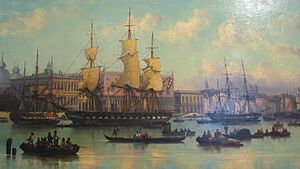
On 10 April 1864, Maximilian and Charlotte were officially named Emperor and Empress of Mexico at Miramare Castle. Maximilian believed that the Mexican people wanted him to be their leader. However, he was mainly convinced by a few Mexican conservatives who wrongly told him he had huge popular support.
The new Emperor felt very overwhelmed that evening. Charlotte had to host a dinner alone. Their departure for Mexico was set for 14 April. They sailed on the Austrian frigate SMS Novara, escorted by a French ship. Maximilian felt calmer once they were at sea.

They stopped in Rome to receive a blessing from Pope Pius IX. During their meeting on 19 April, the Pope emphasized that Maximilian must respect the rights of the Church in Mexico.
During the long journey across the ocean, Charlotte and Maximilian spent their time planning their future court. They wrote a detailed 600-page book about how their court should operate. The SMS Novara stopped in Madeira and Jamaica. They also faced heavy storms before a final stop in Martinique. As they approached the port of Veracruz, Charlotte wrote to her grandmother, saying she was excited to reach their new homeland.
Their Time as Rulers
Maximilian and Charlotte arrived in Veracruz on 28 May 1864. They entered Mexico City on 12 June and received a warm welcome. They found the National Palace needed a lot of work. So, they chose Chapultepec Castle as their main home. They also picked the Palace of Cortés in Cuernavaca as a summer home.
Soon after arriving, they began expensive improvements to their properties. This happened even though Mexico's treasury was in a very bad state. Charlotte played a big part in organizing many celebrations, military parades, and balls. She also led the new Imperial Order of Saint Charles. This award was given for good service to Mexico.
Despite their happy descriptions of Mexico to family in Europe, they soon realized the country was very unstable. Their homes were always guarded by many soldiers. These guards were there to protect them from rebel groups. French soldiers, along with Belgian and Austrian helpers, supported them. But a long civil war made life in Mexico very difficult. The French army had to fight many small battles against rebels.
A small group of conservative Mexicans supported the Empire. This included nobles, clergy, and some native groups. Maximilian tried to bring together the liberal and conservative groups. He decided to follow a liberal policy. He approved the government taking over church property. This angered the conservatives and the clergy.
When Maximilian was away from Mexico City, sometimes for months, he made Charlotte the Regent. This meant she led the Council of Ministers and held public meetings on Sundays. The popularity of the Emperor and Empress began to decline within their first year.
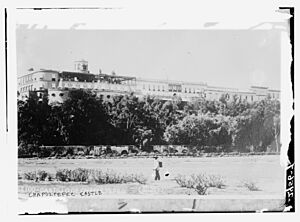
Maximilian and Charlotte did not have children of their own. In September 1865, Maximilian decided to adopt Agustín de Iturbide y Green and Salvador de Iturbide y de Marzán. These boys were grandsons of Agustín I de Iturbide, an earlier Emperor of Mexico. Agustín was only two years old when adopted. Maximilian gave Agustín the title "His Highness, The Prince of Iturbide." Other family members also received imperial titles.
A year after they arrived, Mexico remained unstable. Charlotte wrote that disasters kept happening. The constant money problems made relations between France and Mexico worse. Mexican Republicans, led by former President Benito Juárez, started getting more support. They received men and weapons from the United States of America, where the Civil War had just ended.
The Belgian Legion, a group of 4,000 soldiers, was defeated by Juárez's troops. This happened at the Battle of Tacámbaro in April 1865. However, they won another battle in July 1865.
Because of the difficult situation, Maximilian decided to take strong action against the rebels. He issued a "Black Decree" on 3 October 1865. This decree offered forgiveness to rebels who surrendered. But it also stated that anyone belonging to armed groups without permission would be tried by military courts. If found guilty, they would be sentenced to death and executed quickly. Many rebels and political opponents were executed under this decree.
Trip to Yucatán and Leaving Mexico

On 6 November 1865, Charlotte began an official visit to Yucatán. This trip lasted almost two months. She traveled without Maximilian but with many attendants. Yucatán was far from the fighting in other parts of Mexico. The people there welcomed the Empress warmly. There were many celebrations before she arrived in Mérida, the capital of the province.
Charlotte visited the ancient Maya city of Uxmal. She admired the old ruins there. During her trip, she wrote many letters and reports about the peninsula. These are now kept in archives. When Charlotte met Maximilian again in Cuernavaca, she learned about his new plans. On 6 January, she received news that her father, King Leopold I of Belgium, had died almost four weeks earlier. Two months later, on 24 March, Charlotte learned that her beloved grandmother, Maria Amalia, had also died in England.
In January 1866, Napoleon III decided to withdraw his troops from Mexico. This was because the French public was against the Mexican expedition. This decision was a huge blow to the Mexican monarchy. After the French left, Maximilian would only have a small force of Mexican soldiers and some Belgian and Austrian volunteers. These would be easily outnumbered by the rebel forces.
The news of the French withdrawal caused the Belgian representatives to leave Mexico. In a desperate attempt to save her husband's throne, Charlotte decided to go to Europe herself. She wanted to convince Napoleon III to change his mind. On 9 July 1866, Charlotte sailed from Veracruz to Europe on the ship Impératrice Eugénie. She was joined by Mexico's Minister of Foreign Affairs and her two adopted sons.
Return to Europe
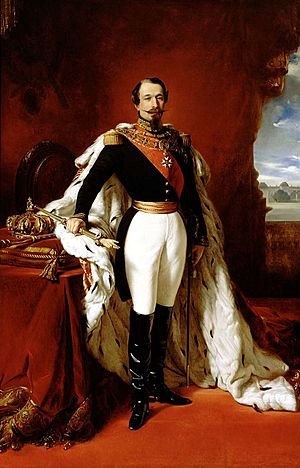
On 8 August 1866, Empress Charlotte arrived in Europe. She landed at the port of Saint-Nazaire in France. She was greeted by Mexican officials, but there was no official welcome ceremony. From there, she took a train to Paris, arriving on 9 August. Charlotte had received a telegram from Napoleon III saying he was ill. But she was determined to meet him.
At the Château de Saint-Cloud, Napoleon III was in bed. He sent his wife, Empress Eugénie, to Charlotte's hotel. Eugénie hoped to stop Charlotte from meeting the Emperor in person. But Charlotte insisted. So, Eugénie arranged a meeting for the next day, 11 August, at Saint-Cloud.
Charlotte had carefully prepared her arguments. But her meeting with Napoleon III failed completely. She gave a long, emotional speech. She reminded him of his promises and the Treaty of Miramar. But the Emperor would not change his mind. He said he could not decide without his ministers' approval. He refused to offer more money or military help for Mexico.
After this failure, Charlotte began to show signs of great distress. She became very worried and confused. Two days later, she returned to Saint-Cloud to try again. A heated discussion took place. Empress Eugénie pretended to faint. Charlotte herself became overwhelmed with sadness and cried. This was one of the first signs of her mental health struggles. On 18 August 1866, Napoleon III's ministers confirmed his decision. They formally opposed keeping any French soldiers in Mexico. The next day, Napoleon III personally visited Charlotte to confirm that France would no longer help Mexico.
Shaken by Napoleon III's refusal, Charlotte left France for Miramare Castle in Trieste on 21 August. During the journey, her mental health worsened. She became convinced that a farmer she saw was an assassin. She shouted at her coachman to drive faster. She avoided going through Brussels and Vienna. This was because Belgian and Austrian troops were also leaving Mexico. Charlotte did not seek help from her family or her husband's family. Her late father, King Leopold I, had doubted the Mexican plan. Her brother, now Leopold II, could not ignore how much Belgians were against further involvement in Mexico. Charlotte was now alone and could not get more European support.
At Miramare, Charlotte found a message from Maximilian. He asked her to meet Pope Pius IX in Rome. After a month in Trieste, Charlotte left for the Vatican. She hoped to get the Pope's support for the Mexican Empire. However, Pope Pius IX did not want the Church to get more involved in the failing Mexican venture. On her way to Rome, Charlotte showed more signs of her worsening mental state. She stopped in Bolzano and told her companion that she felt unwell. She insisted it was because spies were trying to poison her.
On 24 September 1866, Charlotte arrived in Rome. Three days later, she met Pope Pius IX. As expected, the Pope was unwilling to use his influence to help the Mexican Empire. Charlotte became very sad and distressed. Overwhelmed by despair and worry, she stayed in her hotel room. She wore mourning clothes. Fearing poison, she refused food and water. She asked to be taken to the Trevi Fountain to drink water.
On 1 October, Charlotte went to the Vatican for another meeting with the Pope. She was still in mourning clothes. Her face looked tired and flushed. Crying, she refused to return to her hotel. She begged to stay in the papal apartments, convinced that assassins were waiting for her outside. The Pope allowed Charlotte to eat some of his dinner. He even had a bed moved into the pontifical library for her. This made Charlotte the first woman known to have slept in the Vatican. In the following days, she stayed in her hotel room. She only left to drink water from public fountains, using a cup she took from the papal apartments.
King Leopold II was worried about Charlotte. He sent his brother, Prince Philippe, Count of Flanders, to Rome. Prince Philippe arrived on 8 October 1866. Two days later, he took his very distressed sister and the two princes of Iturbide to Miramare Castle. There, Charlotte continued to be obsessed with the idea of being poisoned. Prince Philippe reported her strange behavior to King Leopold II.
A doctor from Vienna examined Charlotte. He diagnosed her with "madness with fixed ideas of persecution." He believed that the Mexican climate and the difficult experiences in France made her condition worse. At Miramare, Charlotte was kept in a special pavilion, watched by Austrian security.

News of Maximilian's capture and execution in Mexico on 19 June 1867 reached Europe. The Belgian royal family returned to Brussels. Charlotte's family decided not to tell her about her husband's death. After Maximilian's death, who would care for Charlotte became an issue. She had accepted staying at Miramare because she believed her husband wanted it for her safety. Her brother, Leopold II, wanted her to return to Belgium.
However, after Maximilian's arrest, his brother Emperor Franz Joseph I had given Maximilian back his titles as a member of the House of Habsburg. He hoped this would save Maximilian's life. Because of this, Charlotte was still considered an Archduchess of Austria. Her in-laws believed they were still her legal guardians.
The Emperor of Austria sent officials to Miramare Castle. They wanted Charlotte to stay there. In July 1867, King Leopold II sent his wife, Queen Marie Henriette of Austria, to Vienna. She was to ask the Emperor to allow Charlotte to return to Belgium. When Queen Marie Henriette arrived at Miramare on 14 July 1867, she found Charlotte in a very bad state. Charlotte had been treated like a prisoner for nine months.
After two weeks of talks, Queen Marie Henriette succeeded in getting Charlotte released. She convinced Charlotte to return to Belgium. This was helped by a Belgian doctor sent by Leopold II. The doctor and his team kept Charlotte under close watch. They decided that she should not be told about her husband's execution. Queen Marie Henriette and the medical team created a plan. They gave Charlotte a fake telegram from Maximilian, asking her to come back to Brussels. The plan worked. Charlotte left Miramare for the last time with the Belgian group.
After Charlotte left Austria, Vienna and Brussels continued to argue about her inheritance. Emperor Franz Joseph I placed Charlotte under the care of his younger brother. This was to protect her wealth. Some historians believe that after Maximilian's execution, Charlotte's in-laws were more concerned about her money than her well-being. Keeping her in Miramare meant her fortune was guarded by Austrian officials. But when she returned to Belgium, the Austrian court had to pay her dowry to Leopold II.
Return to Belgium
When Charlotte arrived in Belgium, she lived in the Pavilion de Tervueren near Brussels until October 1867. This home was not well furnished or heated in winter. So, she moved to the Palace of Laeken with King Leopold II and Queen Marie Henriette. She lived in her brothers' old apartments.
In January 1868, Charlotte finally learned that her husband had been executed six months earlier. She was devastated. In many letters found in 1995, she wrote that she felt "dead" after the fall of the Mexican Empire. These letters show her daily life, which included moments of worry and the treatments she received.
Charlotte's two adopted sons, the Princes of Iturbide, came with her to Belgium. Later, they were sent to study in England. Agustín de Iturbide y Green later moved to the United States, while Salvador de Iturbide y de Marzán stayed in Europe.
In May 1869, Charlotte left the Palace of Laeken and returned to the Pavilion de Tervueren. Thirty-seven people were assigned to care for her. She continued to honor her late husband's memory. She collected everything that had belonged to him. The Pavilion de Tervueren was destroyed by a fire in March 1879. Charlotte was surprisingly happy about this. After the fire, she moved permanently to Bouchout Castle in Meise. This castle was not far from the Palace of Laeken. Her brother, King Leopold II, bought it for her. In his last years, the King carefully watched over his sister's care. Charlotte wrote notes expressing her deep thanks for the care she received from her brother and nephews.
Her Later Years
Charlotte completely disappeared from public life. She was protected by the high gates of her estate and guards. Only her family visited her, mainly her sisters-in-law, Queen Marie Henriette and the Countess of Flanders. On Sundays, a priest came to say mass at Bouchout Castle. To pass the time, she went for walks, embroidered, played cards, and listened to her gramophone. She was not told about the deaths of her close relatives, like King Leopold II in 1909 or her sister-in-law in 1912. This was because she never asked about their absence.
Her lady-in-waiting described Charlotte as often quiet or having heated discussions with imaginary people. These discussions were often confusing. Sometimes, she would say things that showed she was thinking about her sad past. For example, she might say, "Sir, one told you that one had had a husband; a husband, sir, and then madness! Madness is made of events! If he had been helped by Napoleon!..." Her great-niece and great-nephew remembered her as an elderly lady who made confused remarks. Clear moments became rarer over time. During difficult times, she would become very angry. She would break dishes and vases, and tear up pictures and books. These angry outbursts would alternate with calm periods when she did simple activities.
During World War I, Belgium was invaded by Germany. Only a small part of the country remained free. Charlotte did not see her family during the war. But her status as an Archduchess of Austria protected her from the German occupiers. Her life continued as before. She flew the Austro-Hungarian flag on the roof of Bouchout Castle. In March 1916, a German officer asked why the Austrian flag was flying in occupied Belgium. In response, a German general ordered a sign to be placed at the castle gates. It read: "This domain, property of the Crown of Belgium, is occupied by Her Majesty the Empress of Mexico, Archduchess Maximilian of Austria, sister-in-law of Emperor Franz Joseph, our illustrious ally. I order the German soldiers passing by here not to ring the bell and to leave the place untouched."
Her Death
Charlotte died peacefully at Bouchout Castle on 19 January 1927. She was 86 years old. She developed pneumonia after getting the influenza. There are different stories about her last words:
- Some say she sighed, holding a rosary, and whispered: "Mexico."
- Others say she said: "Remind the universe of the beautiful blond-haired foreigner. God willing we are remembered with sadness, but without hatred."
- Another version states: "All that ended without being successful."
- One of her ladies-in-waiting said Charlotte's last words were: "I expressed myself badly in words and I will regret it."
Three days later, on 22 January, her coffin was carried by six former Belgian soldiers who had served in Mexico. She was buried in the Royal Crypt of the Church of Our Lady of Laeken. King Albert I and his sons were present. A funeral service was held on 25 January in the church of Meise. The entire Belgian Royal family attended. Much of Charlotte's personal wealth was managed by King Leopold II. This money was later used to help fund the Belgian colony in Congo.
Since 1902, Charlotte had hosted a painter named Edwin Ganz at Bouchout. He was known for painting horses and was close to the royal family. After Charlotte's death, the artist continued to live in the castle's outbuildings until he died in 1948.
In 1938, the Belgian State bought Bouchout Castle. They wanted to create the National Botanical Garden of Belgium there. The garden opened 20 years later. It is now called the Meise Botanic Garden. The castle's interior was renovated in the 1980s. It is now used for meetings, conferences, exhibitions, and other events.
Charlotte's Mental Health
The exact nature of Charlotte's mental health struggles is hard to know for sure. Many ideas have been suggested.
Some authors believe her illness was caused by poisoning. One theory suggests that a Mexican court doctor secretly added a substance called bromide to Charlotte's coffee. In Mexico, rumors spread in 1867 that her illness was due to a slow poison. Charlotte herself wrote to her husband in December 1865, saying, "On several occasions it seemed to me that there was poison in the air."
Other authors focus on the psychological reasons for her illness. They look at Charlotte's letters and doctor's reports. They suggest that her life experiences contributed to her struggles. These include losing her mother at age 10, which changed her personality. Her strong sense of duty, deep religious beliefs, and idealization of Maximilian also played a part. The disappointments she faced in Italy and Mexico, and the lack of a close married life, were also mentioned. Some also point to early signs of her illness, like feeling unwell in Uxmal. Her reactions to the deaths of her father and grandmother, and her difficult arrival in Europe, are also seen as factors that led to her long-term mental health challenges.
Titles and Honors
Titles She Held
When Charlotte was born, she was called Princess of Saxe-Coburg and Gotha and Duchess in Saxony. She was also unofficially known as Princess of Belgium. This title became official in 1891. From 1864 until her death, she was known as Her Imperial Majesty the Empress of Mexico.
Honors She Received
 Mexican Empire:
Mexican Empire:
- Grand Mistress and Dame Grand Cross of the Imperial Order of San Carlos for Noble Ladies
- Dame Grand Cross of the Imperial Order of the Mexican Eagle
- Dame Grand Cross of the Imperial Order of Guadalupe
 Austrian Empire: Dame of the Imperial Order of the Starry Cross
Austrian Empire: Dame of the Imperial Order of the Starry Cross Sovereign Military Order of Malta: Dame Grand Cross of Honour and Devotion
Sovereign Military Order of Malta: Dame Grand Cross of Honour and Devotion Kingdom of Portugal: Dame Grand Cross of the Order of Saint Isabel, 19 April 1865
Kingdom of Portugal: Dame Grand Cross of the Order of Saint Isabel, 19 April 1865 Spain: 525th Dame of the Order of Queen Maria Luisa, 22 December 1857
Spain: 525th Dame of the Order of Queen Maria Luisa, 22 December 1857
Images for kids
See also
 In Spanish: Carlota de México para niños
In Spanish: Carlota de México para niños
- List of heads of state of Mexico
- Baron Auguste Goffinet



